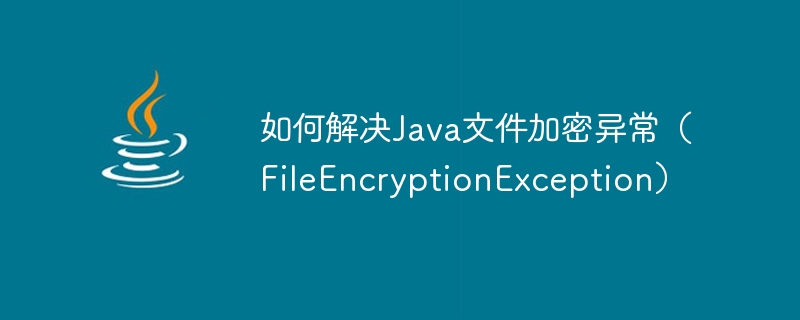

How to solve Java file encryption exception (FileEncryptionException)
Introduction: In Java programming, we often encounter situations where files need to be encrypted. However, sometimes exceptions may occur during file encryption, and the most common exception is FileEncryptionException. This article describes how to resolve this exception and provides corresponding code examples.
1. Understanding FileEncryptionException
FileEncryptionException refers to the exception that occurs when using Java for file encryption. It is an exception class in the Java standard library and is a subclass of IOException. When we perform file encryption operations, abnormal situations that may be encountered include but are not limited to:
If the above exception occurs during the encryption process, the system will throw FileEncryptionException. In order to better solve this exception, we need to deal with specific exception situations.
2. Methods to solve FileEncryptionException exceptions
For different FileEncryptionException exceptions, we can take the following measures to solve them:
try {
File file = new File("path/to/file.txt");
if (!file.exists()) {
file.createNewFile();
}
// 进行加密操作
} catch (IOException e) {
// 异常处理
}try {
File file = new File("path/to/file.txt");
if (!file.canRead() || !file.canWrite()) {
// 检查文件权限
throw new SecurityException("当前用户无法读取或写入文件");
}
// 进行加密操作
} catch (IOException e) {
// 异常处理
}try {
File file = new File("path/to/file.txt");
// 尝试关闭文件占用的资源
// ...
// 进行加密操作
} catch (IOException e) {
// 异常处理
}try {
File file = new File("path/to/file.txt");
// 使用AES算法进行加密
Cipher cipher = Cipher.getInstance("AES/CBC/PKCS5Padding");
// ...
// 进行加密操作
} catch (IOException | NoSuchAlgorithmException | NoSuchPaddingException e) {
// 异常处理
}3. Summary
During the Java file encryption process, you may encounter a FileEncryptionException exception. For different abnormal situations, we can take different measures to solve the exceptions. This includes checking whether the file exists, checking file permissions, closing resources occupied by the file, and using appropriate encryption algorithms. By correctly handling these exceptions, we can better ensure the security and stability of file encryption.
The above are methods to solve Java file encryption exceptions and corresponding code examples. I hope this article will help you with the unusual problems you encounter during the Java file encryption process.
The above is the detailed content of How to solve Java file encryption exception (FileEncryptionException). For more information, please follow other related articles on the PHP Chinese website!




